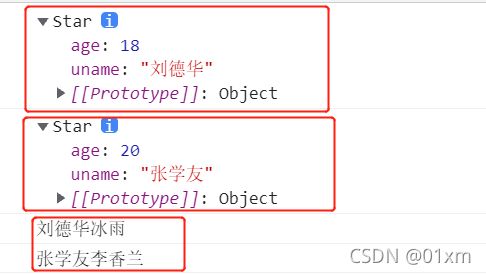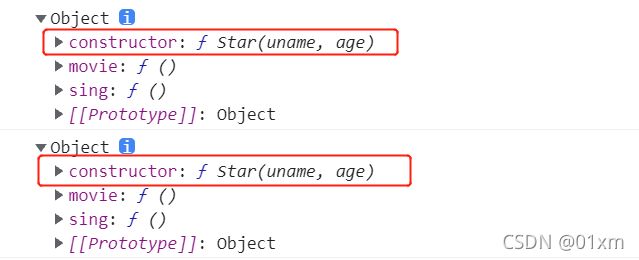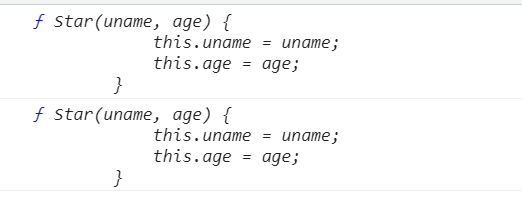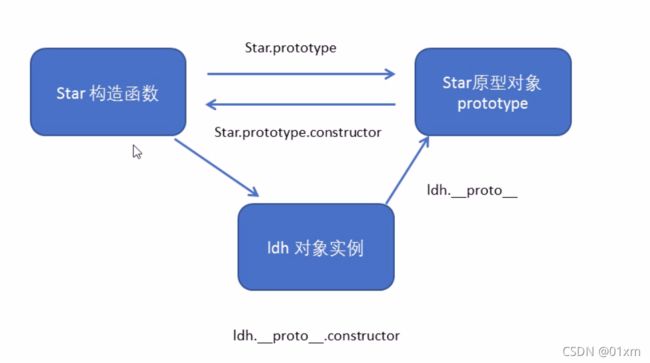【JavaScript】ES6之面向对象的对象、类、构造函数、原型对象、对象原型、原型链
ES6面向对象
- 1、面向对象
-
- 1.1、对象
- 1.2、类
-
- 1.2.1、创建类
- 1.2.2、构造函数
- 1.2.3、类中添加方法
- 1.3 、类的继承
- 1.4、super关键字
-
- 1.4.1、调用父类的构造函数
- 1.4.2、调用父类的普通函数
- 1.4、三个注意点
- 2、构造函数和原型
-
- 2.1、概述
- 2.2、构造函数
-
- 2.2.1、静态成员和实例成员
- 2.2.2、构造函数的问题
- 2.3、构造函数原型 prototype
- 2.4、对象原型 __ proto __
- constructor 构造函数
- 2.6、构造函数、实例、原型对象三者关系
- 2.7、原型链查找规则
- 2.8、原型对象this指向
1、面向对象
面向对象更贴近我们的实际生化,可以使用面向对象描述现实世界事物,但是事物分为具体的事物和抽象的事物
面向对象的思维特点:
- 抽取(抽象)对象共用的属性和行为组织(封装)成一个类(模板)。
- 对类进行实例化,获取类的对象。
1.1、对象
在 JavaScript 中,对象是一组无序的相关属性和方法的集合,所有的事物都是对象,例如字符串、数值、数组、函数等。
对象是由属性和方法组成的
- 属性:事物的特征,在对象中用属性来表示
- 方法:事物的行为,在对象中用方法来表示
1.2、类
在 ES6 中新增加了类的概念,可以使用 class 关键字声明一个类,之后以这个类来实例化对象。
- 类抽象了对象的公共部分,它泛指某一大类(class)
- 对象特指某一个,通过类实例化一个具体的对象
1.2.1、创建类
class name {
// class body
}
- 创建实例
var XX = new name();
注意:类必须使用new实例化对象
1.2.2、构造函数
constructor()方法是类的构造函数(默认方法),用于传递参数,返回实例对象,通过 new 命令生成对象实例时,自动调用该方法。如果没有显示定义, 类内部会自动给我们创建一个constructor()
<script>
// 1. 创建类 class 创建一个 明星类
class Star {
// constructor 构造器或者构造函数
constructor(uname, age) {
this.uname = uname;
this.age = age;
}
}
// 2. 利用类创建对象 new
var ldh = new Star('刘德华', 18);
var zxy = new Star('张学友', 20);
console.log(ldh);
console.log(zxy);
</script>
- 通过
class关键字创建类,类名我们还是习惯性定义首字母大写; - 类里面有个
constructor函数,可以接收传递过来的参数,同时返回实例对象 constructor函数只要new生成实例时,就会自动调用这个函数,如果我们不写这个函数,类也会自动生成这个函数- 最后注意语法规范
- 创建类➡类名后面不要加小括号
- 生成实例➡类名后面加小括号
- 构造函数不需要加 function 关键字
1.2.3、类中添加方法
语法:
class Person {
constructor(name,age) {
// constructor 称为构造器或者构造函数
this.name = name;
this.age = age;
}
say() {
console.log(this.name + '你好');
}
}
var ldh = new Person('刘德华', 18);
ldh.say() //刘德华你好
注意: 方法之间不能加逗号分隔,同时方法不需要添加 function 关键字。
<script>
// 1. 创建类 class 创建一个 明星类
class Star {
// 类的共有属性放到 constructor 里面
constructor(uname, age) {
this.uname = uname;
this.age = age;
}
sing(song) {
console.log(this.uname + song);
}
}
// 2. 利用类创建对象 new
var ldh = new Star('刘德华', 18);
var zxy = new Star('张学友', 20);
console.log(ldh);
console.log(zxy);
// (1) 我们类里面所有的函数不需要写function
// (2) 多个函数方法之间不需要添加逗号分隔
ldh.sing('冰雨');
zxy.sing('李香兰');
</script>
- 类的共有属性放到
constructor里面 - 类里面的函数都不需要写
function关键字
1.3 、类的继承
现实中的继承:子承父业,比如我们都继承了父亲的姓。
程序中的继承:子类可以继承父类的一些属性和方法。
语法:
// 父类
class Father {
}
// 子类继承父类
class Son extends Father {
}
看一个实例:
<script>
// 父类有加法方法
class Father {
constructor(x, y) {
this.x = x;
this.y = y;
}
sum() {
console.log(this.x + this.y);
}
}
// 子类继承父类加法方法 同时 扩展减法方法
class Son extends Father {
constructor(x, y) {
// 利用super 调用父类的构造函数
// super 必须在子类this之前调用
super(x, y);
this.x = x;
this.y = y;
}
subtract() {
console.log(this.x - this.y);
}
}
var son = new Son(5, 3);
son.subtract(); //2
son.sum(); //8
</script>
【注意】:super 必须在子类this之前调用
1.4、super关键字
super关键字用于访问和调用对象父类上的函数,可以调用父类的构造函数,也可以调用父类的普通函数;
1.4.1、调用父类的构造函数
语法:
// 父类
class Person {
constructor(surname){
this.surname = surname;
}
}
// 子类继承父类
class Student entends Person {
constructor(surname,firstname) {
super(surname); //调用父类的 constructor(surname)
this.firstname = firstname; //定义子类独有的属性
}
}
【注意】:子类在构造函数中使用super,必须放到this前面(必须先调用父类的构造方法,在使用子类构造方法)
案例:
// 父类
class Father {
constructor(surname){
this.surname = surname;
}
saySurname() {
console.log('我的姓是' + this.surname);
}
}
// 子类继承父类
class Son extends Father {
constructor(surname,firstname) {
super(surname); //调用父类的 constructor(surname)
this.firstname = firstname; //定义子类独有的属性
}
sayFirstname() {
console.log('我的名字是:' + this.firstname);
}
}
var damao = new Son('刘','德华');
damao.saySurname();
damao.sayFirstname();
1.4.2、调用父类的普通函数
语法:
class Father {
say() {
return '我是爸爸';
}
}
class Son extends Father {
say(){
// super.say() super调用父类的方法
return super.say() + '的儿子';
}
}
var damao = new Son();
console.log(damao.say()); //我是爸爸的儿子
- 多个方法之间不需要添加逗号分隔
- 继承中属性和方法的查找原则:就近原则,先看子类,再看父类
1.4、三个注意点
- 在ES6中类没有变量提升,所以必须先定义类,才能通过类实例化对象
- 类里面的共有属性和方法一定要加
this使用 - 类里面的
this指向:constructor里面的this指向实例对象- 方法里面的
this指向这个方法的调用者
<body>
<button>点击button>
<script>
var that;
var _that;
class Star {
constructor(uname, age) {
// constructor 里面的this 指向的是 创建的实例对象
that = this;
this.uname = uname;
this.age = age;
// this.sing();
this.btn = document.querySelector('button');
this.btn.onclick = this.sing;
}
sing() {
// 这个sing方法里面的this 指向的是 btn 这个按钮,因为这个按钮调用了这个函数
console.log(that.uname);
// that里面存储的是constructor里面的this
}
dance() {
// 这个dance里面的this 指向的是实例对象 ldh 因为ldh 调用了这个函数
_that = this;
console.log(this);
}
}
var ldh = new Star('刘德华');
console.log(that === ldh); //true
ldh.dance();
console.log(_that === ldh); //true
// 1. 在 ES6 中类没有变量提升,所以必须先定义类,才能通过类实例化对象
// 2. 类里面的共有的属性和方法一定要加this使用.
script>
body>
2、构造函数和原型
2.1、概述
在典型的 OOP 的语言中(如 Java),都存在类的概念,类就是对象的模板,对象就是类的实例,但在 ES6之前, JS 中并没用引入类的概念。
ES6, 全称 ECMAScript 6.0 ,2015.06 发版。但是目前浏览器的 JavaScript 是 ES5 版本,大多数高版本的浏览器也支持 ES6,不过只实现了 ES6 的部分特性和功能。
在 ES6之前 ,对象不是基于类创建的,而是用一种称为构造函数的特殊函数来定义对象和它们的特征。
- 创建对象有三种方式
- 对象字面量
- new Object()
- 自定义构造函数
// 1. 利用 new Object() 创建对象
var obj1 = new Object();
// 2. 利用对象字面量创建对象
var obj2 = {
};
// 3.利用构造函数创建对象
function Star(uname,age) {
this.uname = uname;
this.age = age;
this.sing = function() {
console.log('我会唱歌');
}
}
var ldh = new Star('刘德华',18);
注意:
- 构造函数用于创建某一类对象,其首字母要大写
- 构造函数要和
new一起使用才有意义
2.2、构造函数
- 构造函数是一种特殊的函数,主要用来初始化对象(为对象成员变量赋初始值),它总与
new一起使用 - 我们可以把对象中的一些公共的属性和方法抽取出来,然后封装到这个函数里面
new 在执行时会做四件事
- 在内存中创建一个新的空对象。
- 让 this 指向这个新的对象。
- 执行构造函数里面的代码,给这个新对象添加属性和方法。
- 返回这个新对象(所以构造函数里面不需要 return )。
2.2.1、静态成员和实例成员
JavaScript 的构造函数中可以添加一些成员,可以在构造函数本身上添加,也可以在构造函数内部的this上添加。通过这两种方式添加的成员,就分别称为静态成员和实例成员。
- 静态成员: 在构造函数本身上添加的成员为静态成员,只能由构造函数本身来访问
- 实例成员: 在构造函数内部创建的对象成员称为实例成员,只能由实例化的对象来访问
// 构造函数中的属性和方法我们称为成员,成员可以添加
function Star(uname,age) {
this.uname = uname;
this.age = age;
this.sing = function() {
console.log('我会唱歌');
}
}
var ldh = new Star('刘德华',18);
// 实例成员就是构造函数内部通过this添加的成员 uname age sing 就是实例成员
// 实例成员只能通过实例化的对象来访问
ldh.sing();
Star.uname; // undefined 不可以通过构造函数来访问实例成员
// 静态成员就是在构造函数本身上添加的成员 sex 就是静态成员
// 静态成员只能通过构造函数来访问
Star.sex = '男';
Star.sex;
ldh.sex; // undefined 不能通过对象来访问
2.2.2、构造函数的问题
构造函数方法很好用,但是存在浪费内存的问题。

uname,age,sing是简单数据类型,而sing是复杂数据类型需要在开辟一个内存空间去存放,明明两个函数代码是一样的,但还是开辟两个内存空间去存储相同的函数,所以存在内存资源浪费的问题。
- 我们希望所有的对象使用同一个函数,这样就比较节省内存
2.3、构造函数原型 prototype
- 构造函数通过原型分配的函数是所有对象所共享的,这样就解决了内存浪费问题
- JavaScript规定,每一个构造函数都有一个
prototype属性,指向另一个对象,注意这个prototype就是一个对象,这个对象的所有属性和方法,都会被构造函数所拥有。 - 我们可以把那些不变的方法,直接定义在
prototype对象上,这样所有对象的实例就可以共享这些方法
<body>
<script>
// 1. 构造函数的问题.
function Star(uname, age) {
//公共属性定义到构造函数里面
this.uname = uname;
this.age = age;
// this.sing = function() {
// console.log('我会唱歌');
// }
}
//公共的方法我们放到原型对象身上
Star.prototype.sing = function() {
console.log('我会唱歌');
}
var ldh = new Star('刘德华', 18);
var zxy = new Star('张学友', 19);
console.log(ldh.sing === zxy.sing); //true
ldh.sing(); //我会唱歌
zxy.sing(); //我会唱歌
// 2. 一般情况下,我们的公共属性定义到构造函数里面, 公共的方法我们放到原型对象身上
</script>
</body>
- 一般情况下,我们的公共属性定义到构造函数里面, 公共的方法我们放到原型对象身上。
问答:原型是什么?
- 一个对象,我们也称为
prototype为原型对象
问答:原型的作用是什么?
- 共享方法(所有的实例都可以共用此方法,不需要在开辟新的内存空间)
2.4、对象原型 __ proto __
- 对象都会有一个属性
__proto__指向构造函数的prototype原型对象,之所以我们对象可以使用构造函数prototype原型对象的属性和方法,就是因为对象有__proto__原型的存在。 _proto_对象原型和原型对象prototype是等价的。_proto_对象原型的意义就在于为对象的查找机制提供一个方向,或者说一条路线,但是它是一个非标准属性,因此实际开发中,不可以使用这个属性,它只是内部指向原型对象prototype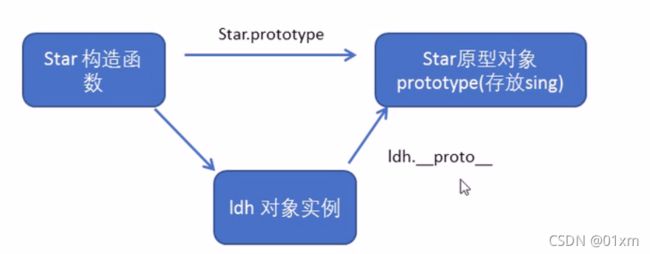
Star.prototype和ldh._proto_指向相同
<body>
<script>
function Star(uname, age) {
this.uname = uname;
this.age = age;
}
Star.prototype.sing = function() {
console.log('我会唱歌');
}
var ldh = new Star('刘德华', 18);
var zxy = new Star('张学友', 19);
ldh.sing();
console.log(ldh);
// 对象身上系统自己添加一个 __proto__ 指向我们构造函数的原型对象 prototype
console.log(ldh.__proto__ === Star.prototype);
// 方法的查找规则: 首先先看ldh 对象身上是否有 sing 方法,如果有就执行这个对象上的sing
// 如果没有sing 这个方法,因为有 __proto__ 的存在,就去构造函数原型对象prototype身上去查找sing这个方法
script>
body>
constructor 构造函数
- 对象原型
(__ proto __)和 构造函数(prototype)原型对象 里面都有一个属性constructor属性,
constructor我们称为构造函数,因为它指回构造函数本身。 constructor主要用于记录该对象引用于哪个构造函数,它可以让原型对象重新指向原来的构造函数。- 一般情况下,对象的方法都在构造函数(prototype)的原型对象中设置
- 如果有多个对象的方法,我们可以给原型对象
prototype采取对象形式赋值,但是这样会覆盖构造函数原型对象原来的内容,这样修改后的原型对象constructor就不再指向当前构造函数了。此时,我们可以在修改后的原型对象中,添加一个constructor指向原来的构造函数
具体请看实例配合理解
<body>
<script>
function Star(uname, age) {
this.uname = uname;
this.age = age;
}
// 很多情况下,我们需要手动的利用constructor 这个属性指回 原来的构造函数
// Star.prototype.sing = function() {
// console.log('我会唱歌');
// };
// Star.prototype.movie = function() {
// console.log('我会演电影');
// }
Star.prototype = {
// 如果我们修改了原来的原型对象,给原型对象赋值的是一个对象,则必须手动的利用constructor指回原来的构造函数
constructor: Star,
sing: function() {
console.log('我会唱歌');
},
movie: function() {
console.log('我会演电影');
}
}
var ldh = new Star('刘德华', 18);
var zxy = new Star('张学友', 19);
console.log(Star.prototype);
console.log(ldh.__proto__);
console.log(Star.prototype.constructor);
console.log(ldh.__proto__.constructor);
script>
body>
2.6、构造函数、实例、原型对象三者关系
2.7、原型链查找规则
- 当访问一个对象的属性(包括方法)时,首先查找这个对象自身有没有该属性
- 如果没有就查找它的原型(也就是
__proto__指向的prototype原型对象) - 如果还没有就查找原型对象的原型(Object的原型对象)
- 依此类推一直找到Object为止(null)
__proto__对象原型的意义就是在于为对象成员查找机制提供一个方向,或者说一条路线。
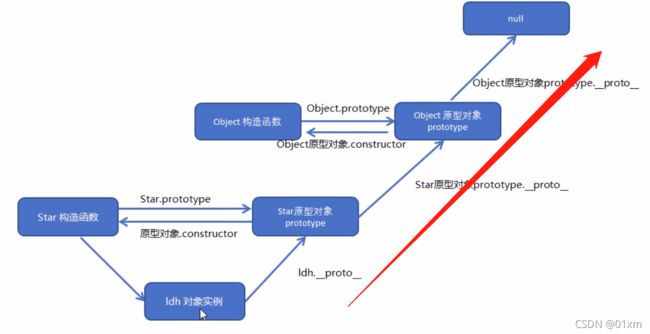
Star构造对象的原型是prototype原型对象,原型对象的constructor属性又指向自己本身的构造函数,构造函数new一个实例对象,对象都会有一个__proto__对象原型指向构造函数的原型对象;原型对象是一个对象,所以他有__proto__对象原型指向Object构造函数的原型对象…
<body>
<script>
function Star(uname, age) {
this.uname = uname;
this.age = age;
}
Star.prototype.sing = function() {
console.log('我会唱歌');
}
var ldh = new Star('刘德华', 18);
// 1. 只要是对象就有__proto__ 原型, 指向原型对象
console.log(Star.prototype);
console.log(Star.prototype.__proto__ === Object.prototype);
// 2.我们Star原型对象里面的__proto__原型指向的是 Object.prototype
console.log(Object.prototype.__proto__);
// 3. 我们Object.prototype原型对象里面的__proto__原型 指向为 null
script>
body>
2.8、原型对象this指向
- 构造函数中的
this指向我们的实例对象 - 原型对象里面放的是方法,这个方法里面的
this指向的是这个方法的调用者,也就是这个实例对象
<body>
<script>
function Star(uname, age) {
this.uname = uname;
this.age = age;
}
var that;
Star.prototype.sing = function() {
console.log('我会唱歌');
that = this;
}
var ldh = new Star('刘德华', 18);
// 1. 在构造函数中,里面this指向的是对象实例 ldh
ldh.sing();
console.log(that === ldh);
// 2.原型对象函数里面的this 指向的是 实例对象 ldh
script>
body>
参考:黑马程序员JavaScript面向对象视频
